rear view mirror RENAULT TALISMAN 2016 1.G User Guide
[x] Cancel search | Manufacturer: RENAULT, Model Year: 2016, Model line: TALISMAN, Model: RENAULT TALISMAN 2016 1.GPages: 328, PDF Size: 3.39 MB
Page 160 of 328
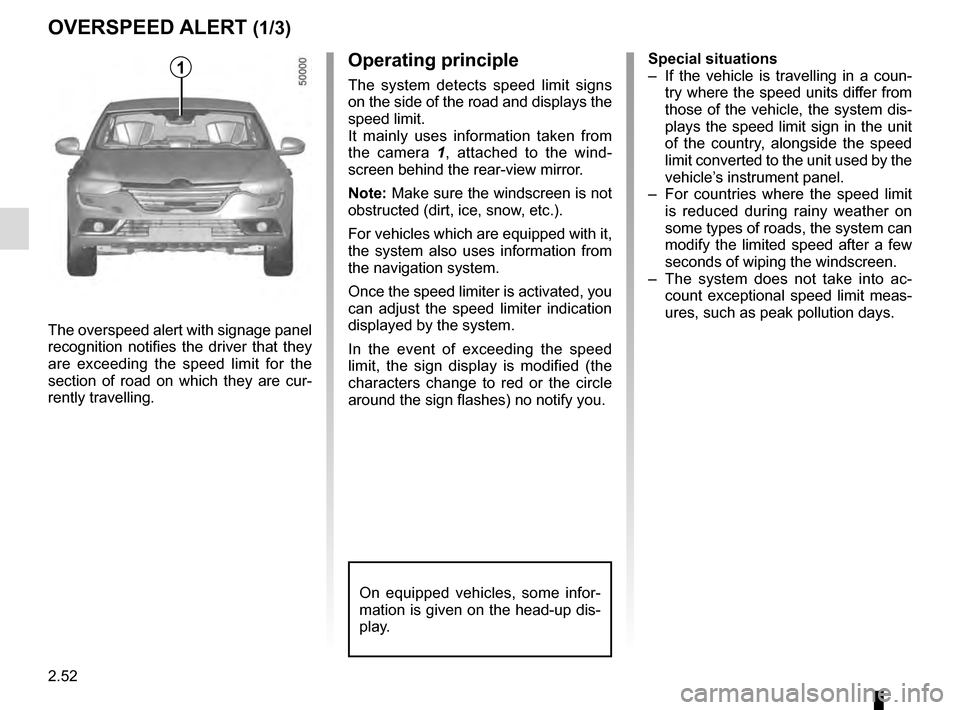
2.52
OVERSPEED ALERT (1/3)
The overspeed alert with signage panel
recognition notifies the driver that they
are exceeding the speed limit for the
section of road on which they are cur-
rently travelling.Special situations
– If the vehicle is travelling in a coun-
try where the speed units differ from
those of the vehicle, the system dis-
plays the speed limit sign in the unit
of the country, alongside the speed
limit converted to the unit used by the
vehicle’s instrument panel.
– For countries where the speed limit is reduced during rainy weather on
some types of roads, the system can
modify the limited speed after a few
seconds of wiping the windscreen.
– The system does not take into ac- count exceptional speed limit meas-
ures, such as peak pollution days.
On equipped vehicles, some infor-
mation is given on the head-up dis-
play.
1Operating principle
The system detects speed limit signs
on the side of the road and displays the
speed limit.
It mainly uses information taken from
the camera 1 , attached to the wind-
screen behind the rear-view mirror.
Note: Make sure the windscreen is not
obstructed (dirt, ice, snow, etc.).
For vehicles which are equipped with it,
the system also uses information from
the navigation system.
Once the speed limiter is activated, you
can adjust the speed limiter indication
displayed by the system.
In the event of exceeding the speed
limit, the sign display is modified (the
characters change to red or the circle
around the sign flashes) no notify you.
Page 181 of 328
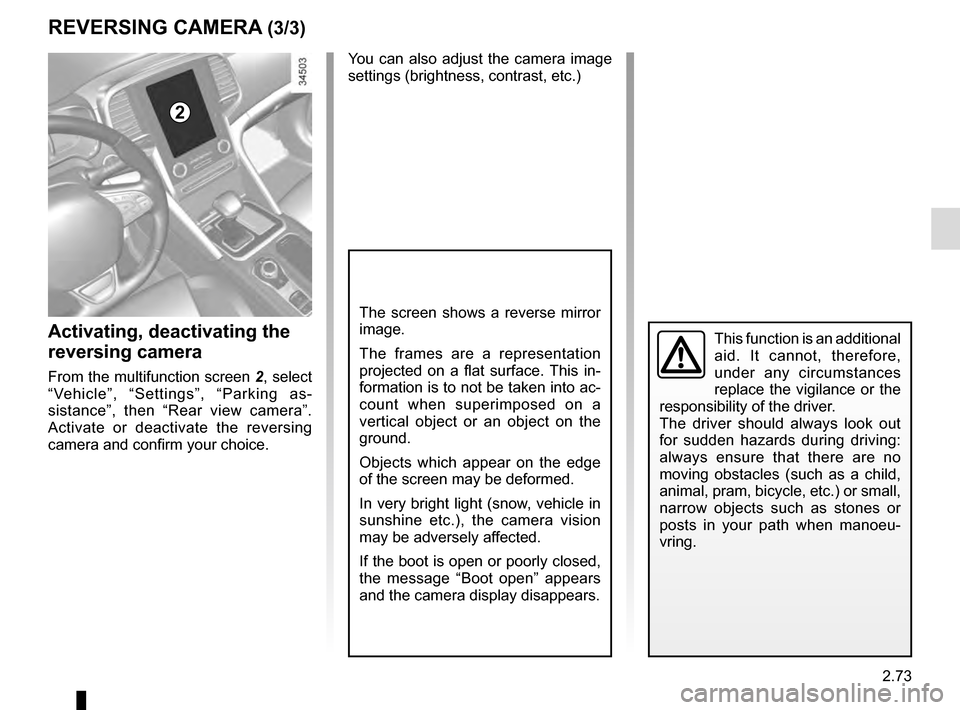
2.73
This function is an additional
aid. It cannot, therefore,
under any circumstances
replace the vigilance or the
responsibility of the driver.
The driver should always look out
for sudden hazards during driving:
always ensure that there are no
moving obstacles (such as a child,
animal, pram, bicycle, etc.) or small,
narrow objects such as stones or
posts in your path when manoeu-
vring.
The screen shows a reverse mirror
image.
The frames are a representation
projected on a flat surface. This in-
formation is to not be taken into ac-
count when superimposed on a
vertical object or an object on the
ground.
Objects which appear on the edge
of the screen may be deformed.
In very bright light (snow, vehicle in
sunshine etc.), the camera vision
may be adversely affected.
If the boot is open or poorly closed,
the message “Boot open” appears
and the camera display disappears.
You can also adjust the camera image
settings (brightness, contrast, etc.)
Activating, deactivating the
reversing camera
From the multifunction screen 2, select
“Vehicle”, “Settings”, “Parking as-
sistance”, then “Rear view camera”.
Activate or deactivate the reversing
camera and confirm your choice.
REVERSING CAMERA (3/3)
2
Page 196 of 328
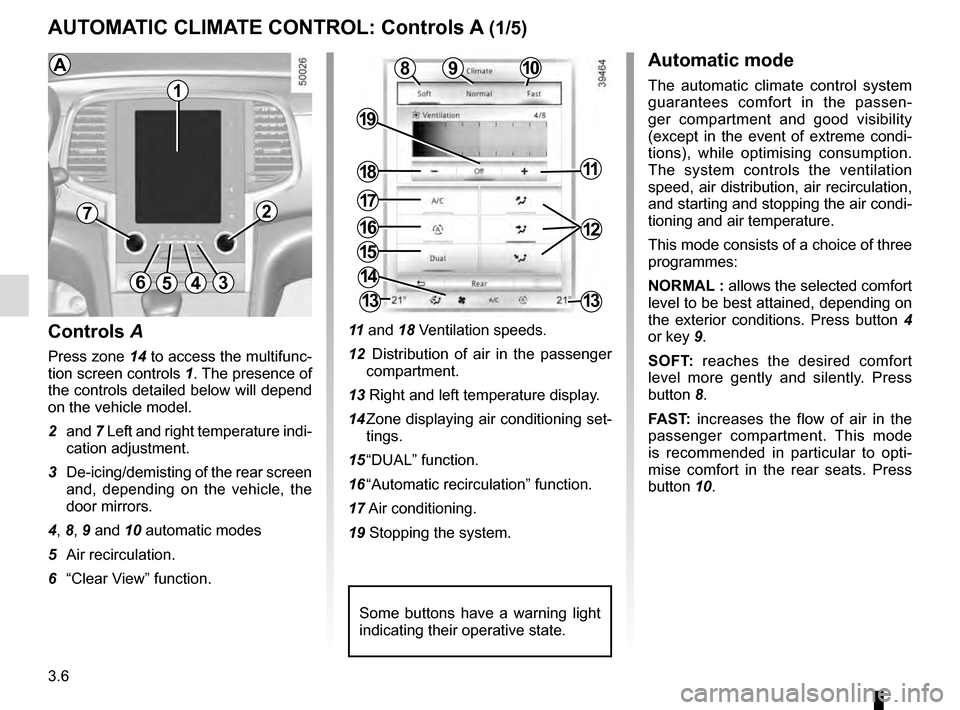
3.6
10
AUTOMATIC CLIMATE CONTROL: Controls A (1/5)
15
6543
9
1216
17
18
19
11
Controls A
Press zone 14 to access the multifunc-
tion screen controls 1. The presence of
the controls detailed below will depend
on the vehicle model.
2 and 7 Left and right temperature indi-
cation adjustment.
3 De-icing/demisting of the rear screen and, depending on the vehicle, the
door mirrors.
4, 8, 9 and 10 automatic modes
5 Air recirculation.
6 “Clear View” function. 11
and 18 Ventilation speeds.
12 Distribution of air in the passenger compartment.
13 Right and left temperature display.
14 Zone displaying air conditioning set- tings.
15 “DUAL” function.
16 “Automatic recirculation” function.
17 Air conditioning.
19 Stopping the system.
8
14
13
72
13
1
Some buttons have a warning light
indicating their operative state.
AAutomatic mode
The automatic climate control system
guarantees comfort in the passen-
ger compartment and good visibility
(except in the event of extreme condi-
tions), while optimising consumption.
The system controls the ventilation
speed, air distribution, air recirculation,
and starting and stopping the air condi-
tioning and air temperature.
This mode consists of a choice of three
programmes:
NORMAL : allows the selected comfort
level to be best attained, depending on
the exterior conditions. Press button 4
or key 9.
SOFT: reaches the desired comfort
level more gently and silently. Press
button 8.
FAST: increases the flow of air in the
passenger compartment. This mode
is recommended in particular to opti-
mise comfort in the rear seats. Press
button 10.
Page 198 of 328
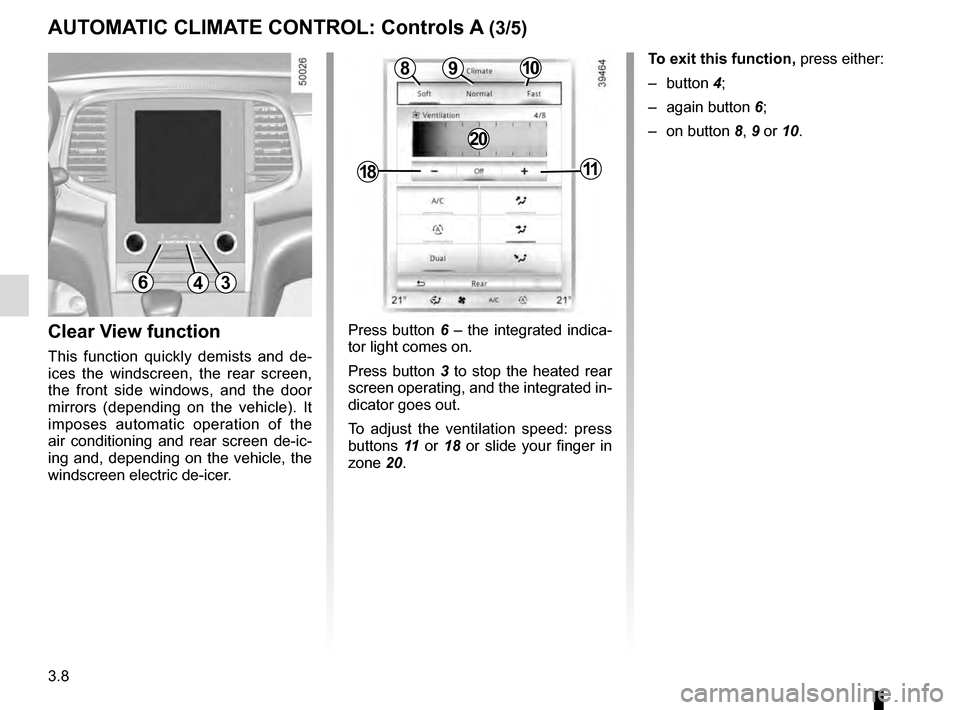
3.8
AUTOMATIC CLIMATE CONTROL: Controls A (3/5)
Clear View function
This function quickly demists and de-
ices the windscreen, the rear screen,
the front side windows, and the door
mirrors (depending on the vehicle). It
imposes automatic operation of the
air conditioning and rear screen de-ic-
ing and, depending on the vehicle, the
windscreen electric de-icer.
643
109
1811
8
20
To exit this function, press either:
– button 4;
– again button 6;
– on button 8, 9 or 10.
Press button 6 – the integrated indica-
tor light comes on.
Press button 3 to stop the heated rear
screen operating, and the integrated in-
dicator goes out.
To adjust the ventilation speed: press
buttons 11 or 18 or slide your finger in
zone 20.
Page 201 of 328
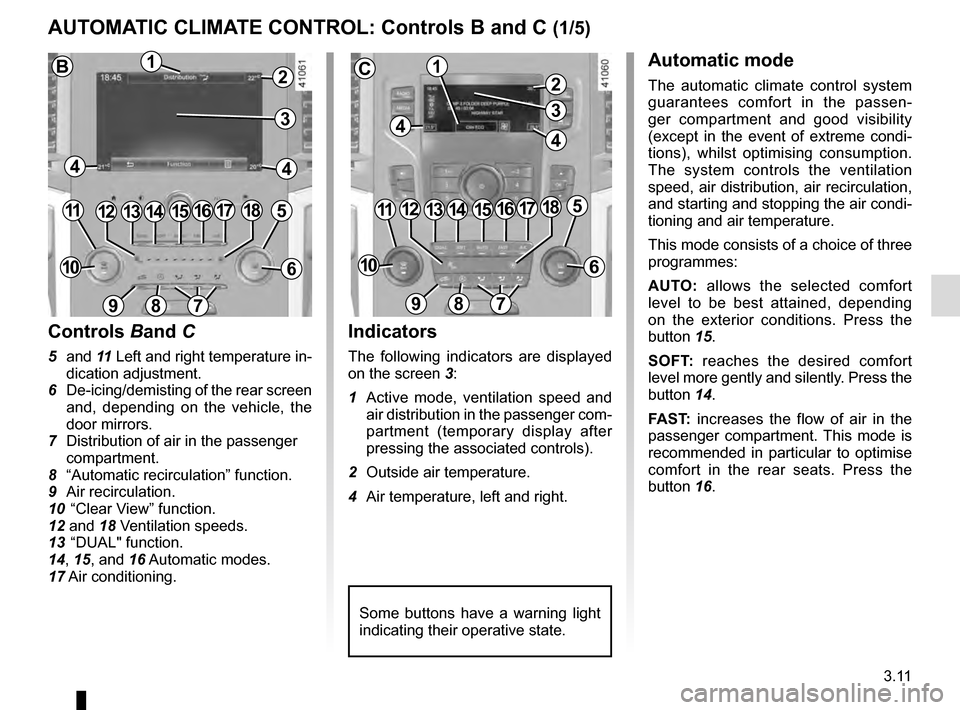
3.11
AUTOMATIC CLIMATE CONTROL: Controls B and C (1/5)
Indicators
The following indicators are displayed
on the screen 3:
1 Active mode, ventilation speed and air distribution in the passenger com-
partment (temporary display after
pressing the associated controls).
2 Outside air temperature.
4 Air temperature, left and right.
Automatic mode
The automatic climate control system
guarantees comfort in the passen-
ger compartment and good visibility
(except in the event of extreme condi-
tions), whilst optimising consumption.
The system controls the ventilation
speed, air distribution, air recirculation,
and starting and stopping the air condi-
tioning and air temperature.
This mode consists of a choice of three
programmes:
AUTO: allows the selected comfort
level to be best attained, depending
on the exterior conditions. Press the
button 15.
SOFT: reaches the desired comfort
level more gently and silently. Press the
button 14.
FAST: increases the flow of air in the
passenger compartment. This mode is
recommended in particular to optimise
comfort in the rear seats. Press the
button 16.
10
Some buttons have a warning light
indicating their operative state.
1113141512
89
6
Controls Band C
5 and 11 Left and right temperature in-
dication adjustment.
6 De-icing/demisting of the rear screen and, depending on the vehicle, the
door mirrors.
7 Distribution of air in the passenger compartment.
8 “Automatic recirculation” function.
9 Air recirculation.
10 “Clear View” function.
12 and 18 Ventilation speeds.
13 “DUAL" function.
14, 15, and 16 Automatic modes.
17 Air conditioning.
7
1851716
1
44
2
10
1113141512
89
6
7
1851716
1
44
2
BC
33
Page 203 of 328
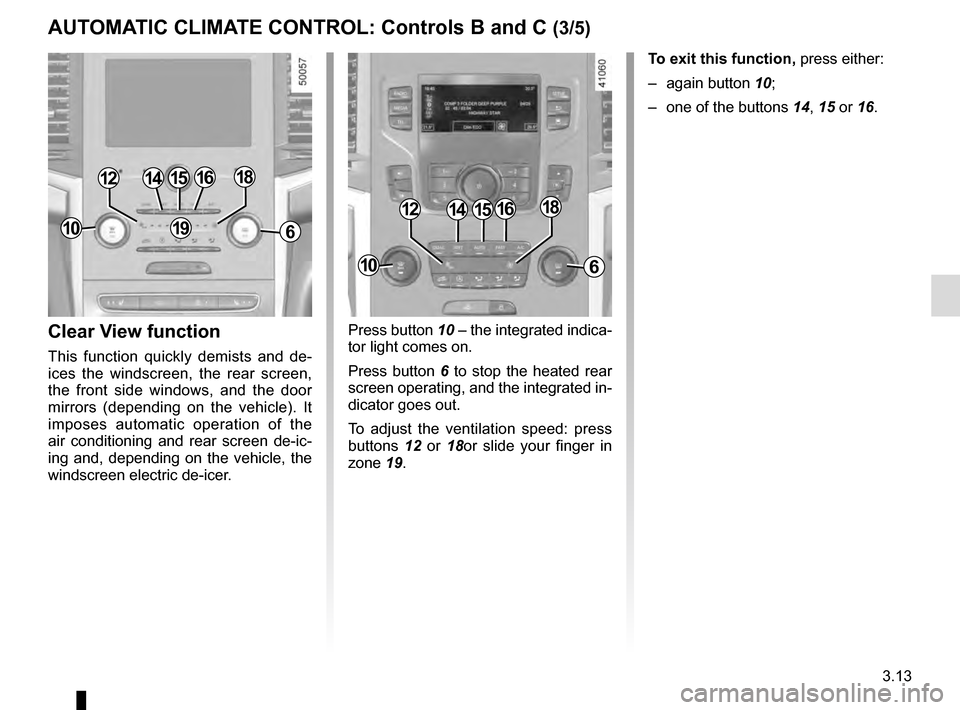
3.13
Press button 10 – the integrated indica-
tor light comes on.
Press button 6 to stop the heated rear
screen operating, and the integrated in-
dicator goes out.
To adjust the ventilation speed: press
buttons 12 or 18or slide your finger in
zone 19.Clear View function
This function quickly demists and de-
ices the windscreen, the rear screen,
the front side windows, and the door
mirrors (depending on the vehicle). It
imposes automatic operation of the
air conditioning and rear screen de-ic-
ing and, depending on the vehicle, the
windscreen electric de-icer. To exit this function,
press either:
– again button 10;
– one of the buttons 14, 15 or 16.
141512
6
1816
1910
10
141512
6
1816
AUTOMATIC CLIMATE CONTROL: Controls B and C (3/5)
Page 324 of 328
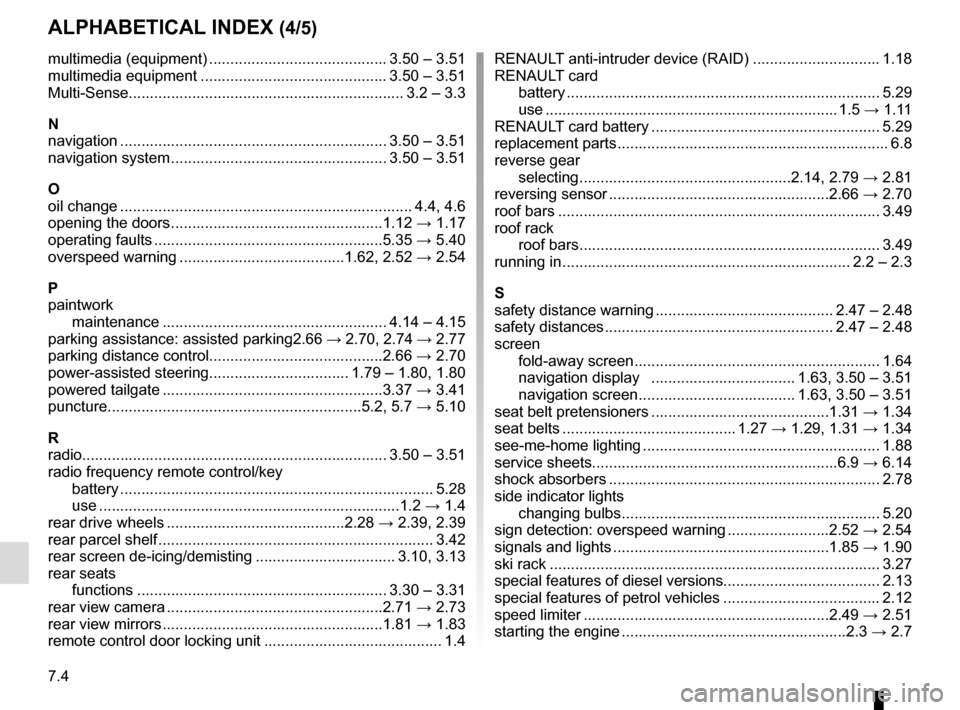
7.4
ALPHABETICAL INDEX (4/5)
multimedia (equipment) .......................................... 3.50 – 3.51
multimedia equipment ............................................ 3.50 – 3.51
Multi-Sense.............................................................\
.... 3.2 – 3.3
N
navigation ............................................................... 3.50 – 3.51
navigation system ................................................... 3.50 – 3.51
O
oil change ..................................................................... 4.4, 4.6
opening the doors ..................................................1.12 → 1.17
operating faults ......................................................5.35 → 5.40
overspeed warning .......................................1.62, 2.52 → 2.54
P
paintwork maintenance ..................................................... 4.14 – 4.15
parking assistance: assisted parking 2.66 → 2.70, 2.74 → 2.77
parking distance control.........................................2.66 → 2.70
power-assisted steering................................. 1.79 – 1.80, 1.80
powered tailgate ....................................................3.37 → 3.41
puncture............................................................5.2,\
5.7 → 5.10
R
radio...................................................................\
..... 3.50 – 3.51
radio frequency remote control/key battery ................................................................\
.......... 5.28
use ....................................................................\
...1.2 → 1.4
rear drive wheels ..........................................2.28 → 2.39, 2.39
rear parcel shelf ................................................................. 3.42
rear screen de-icing/demisting ................................. 3.10, 3.13
rear seats functions ........................................................... 3.30 – 3.31
rear view camera ...................................................2.71 → 2.73
rear view mirrors ....................................................1.81 → 1.83
remote control door locking unit .......................................... 1.4 RENAULT anti-intruder device (RAID) .............................. 1.18
RENAULT card battery ................................................................\
.......... 5.29
use ....................................................................\
. 1.5 → 1.11
RENAULT card battery ...................................................... 5.29
replacement parts ................................................................ 6.8
reverse gear selecting ..................................................2.14, 2.79 → 2.81
reversing sensor ....................................................2.66 → 2.70
roof bars ........................................................................\
.... 3.49
roof rack roof bars ....................................................................... 3.49
running in .................................................................... 2.2 – 2.3
S
safety distance warning .......................................... 2.47 – 2.48
safety distances ...................................................... 2.47 – 2.48
screen fold-away screen .......................................................... 1.64
navigation display .................................. 1.63, 3.50 – 3.51
navigation screen ..................................... 1.63, 3.50 – 3.51
seat belt pretensioners ..........................................1.31 → 1.34
seat belts ......................................... 1.27 → 1.29, 1.31 → 1.34
see-me-home lighting ........................................................ 1.88
service sheets..........................................................\
6.9 → 6.14
shock absorbers ................................................................ 2.78
side indicator lights changing bulbs ............................................................. 5.20
sign detection: overspeed warning ........................2.52 → 2.54
signals and lights ...................................................1.85 → 1.90
ski rack ........................................................................\
...... 3.27
special features of diesel versions.....................................\
2.13
special features of petrol vehicles ..................................... 2.12
speed limiter ..........................................................2.49 → 2.51
starting the engine .....................................................2.3 → 2.7